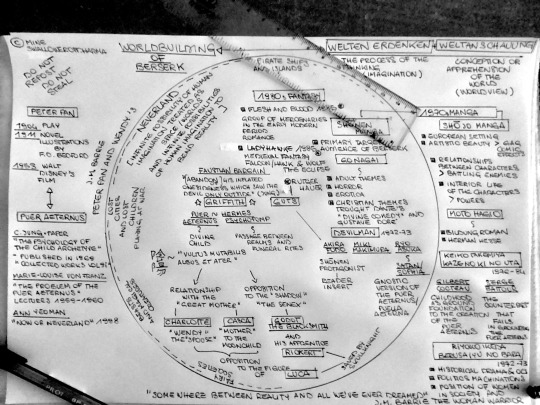#berserk as a Shōjo manga
Explore tagged Tumblr posts
Text
So, what is Berserk about after all?
Please be considerate to me, don’t repost this, don’t share it outside of tumblr, don’t copy parts of it, thank you.

I have read really funny critiques and reviews of Berserk. Often they would refer to Miura supposedly saying that he didn’t plan everything out and they would use this statement to support their argument that after the Golden Age arc the story just looked like it dragged on. One, don’t ever fully believe what artists and writers say about their work. Second, without a proper conclusion it is impossible to make that kind of judgement and the story is ongoing. Then, not having a plan or having just vague ideas and taking inspiration here and there isn’t how manga works or how it gets published. When asked in an interview why he started creating Haibane Renmei as a doujinshi, Yoshitoshi Abe replied: “With mainstream publishing, it would've been difficult to do it with that avenue because of this particular approach with everything being adlibbed. I don't know how the story will be developed, how it's going to end up, or what the ending's going to be. If you go to a mainstream publisher, by their general approach, they have to know what the characters are, who they are, what the story's going to be, and how the story's going to develop so they know if there's going to be a serial, continuing storyline. They need to know how it's going to go”. Even though plans can be renewed and renegotiated, Miura still needed to make solid advanced plans and decisions and respect deadlines and page quotas. Even without considering this, the world building of Berserk seems too intentional and coherent to me to think that he didn’t really know how the story would go. Granted he created a reality that could be changed and bent by the human imagination and psyche, from the inside. This happened to be a brilliant choice for a long project like the Berserk manga.
I once read a review that pointed out the weakness of the later arcs and episodes, making the hypothesis that Miura was influenced by the success of stories like One Piece and Pirates of the Caribbean. I can’t really say that I share this opinion, either. Reviews like these make me smile, because they reveal how people missed a very big clue that Miura never really hid. Berserk was inspired by the story of Peter Pan as told by J.M. Barrie and reinterpreted in several different ways, not only visually. He went as far as dedicating to it the Lost Children chapters, immediately after the Eclipse, when the tension of the story was higher than it ever had been. We should read the Lost Children as an homage to the story of Peter Pan and Wendy that plays into the already disquieting themes of the original in darker tones and with much more horrifying elements; but we should also pay great attention to the Lost Children chapters as an important recontextualization of the events of the Golden Age arc. While I want to dedicate proper analysis and attention to this, I am going to add here that in Peter Pan we already had the pirates, the islands with hidden caves and the mermaids. The journey to Skellig island and Elfhelm had to be long enough for Moonlight Boy to make an appearance at least twice before the big reveal of his full identity the third time, and since he can only appear on nights of a full moon, Miura had to make the readers feel that time had passed. But Guts had always belonged in Neverland.
In my rudimentary outline of various elements that contributed greatly in building the world and story of Berserk, I actually ran out of space. And I want to properly address the various points and develop them more. For the moment I just really wanted to show that Miura had a very strong grip over the story and that he was really attentive to nuances. I said to myself, if I want to criticize the writing in Berserk at least I have to make sure I understand it to a sufficient extent.
Also I really wanted to at least give an idea of how important a role Shōjo manga had to Berserk. I hope to be able to fully explore this element soon.
#berserk meta#eri reads berserk#another little bit of groundwork to give context#berserk as a Shōjo manga#themes: moon
44 notes
·
View notes
Text

Kentarō Miura, ~1991-92

Moto Hagio, ~1992-93
#this is more about broken boyhood than artists quoting each other#hagio sensei’s style is pretty unique and has been consistent throughout the years#moto hagio#kentaro miura#berserk as a shōjo manga
5 notes
·
View notes